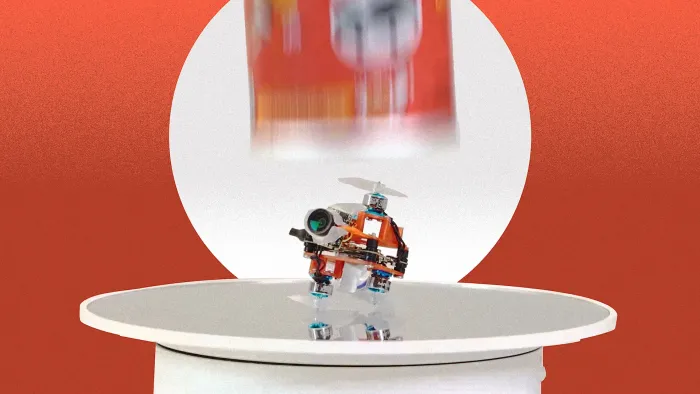
.
Image: Source Image: Hoarder Sam
This drone is so small that it can sneak anywhere.
Flying with the stability and agility of a normal quadcopter, its design is unlike anything you’ve seen before. The tiny aircraft, which could fly comfortably through a Pringles can, also has a built-in camera. Imagine the Death Star’s trench-run-like possibilities.
“I wanted to build the world’s smallest FPV drone,” declares its creator in his how-to video. While there are other commercial drones that are almost as small, I couldn’t find a true first-person-view drone—a remote-controlled aircraft you can maneuver with VR glasses on—that could approach the diminutive size of this thingamajig.
To create the drone, the inventor, who goes by the YouTube alias Hoarder Sam, needed to redesign traditional drones, defying the accepted wisdom in the drone community that quadcopters with a 2.5-inch (65-millimeter) frame are the absolute minimum for stable flight. His flying critter measures just 0.86 inches between rotors, and yet it flies with perfect precision.
Hoarder Sam’s genius wasn’t in inventing new parts or embracing biomimicry, like experimental robotic insects, but in radically rearranging existing parts. The core idea was inspired by an old community design known as a “bone drone,” which overlaps its propellers to create an extremely narrow profile, allowing it to navigate tight spaces.
He started by gutting a popular commercial micro-drone, the BetaFPV Air65, and transplanting its electronics into a completely new, much more compact body.
To understand how radical this is, you have to consider how a standard quadcopter works. Drones achieve stability and movement by precisely controlling the speed of four propellers, each placed at the corner of a square or “X” frame. This layout gives it a stable center of gravity and allows for straightforward control logic. A bone drone throws that convention out the window by stacking the motors and propellers closer together, creating an “I” shape that looks like a comic-book dog bone. This arrangement makes the drone inherently unstable and much harder to control, as the physics of its lift and balance are completely altered.
Sam’s challenge was to make this unstable design work at a micro scale. Using SolidWorks, a 3D modeling program, he designed a new chassis with just 0.86 inches (22 millimeters) between the motors—a nearly 70% reduction from the original Air65. The new 3D-printed skeleton sandwiches the flight controller between two plates and positions the motors on offset mounts. The final structure, fully assembled with its battery and camera, weighs just under an ounce (25 grams).
The drone’s brain is its five-in-one flight controller, which combines five essential components—the flight controller itself, an electronic speed controller (ESC) for each motor, and the radio receiver—onto a single tiny board. It uses an ICM42688P gyroscope—a device that knows the orientation of whatever object it’s attached to—and runs on a central processor unit with an unusually high amount of computing power for its size. This processing is crucial, because the drone’s strange layout requires constant, lightning-fast calculations to stay in the air. The gyroscope feeds motion data to the processor thousands of times per second, and the processor adjusts motor speeds independently in real time to keep the drone from tumbling out of the sky.
This brain is paired with four motors that spin up to 23,000 times per minute, designed to power quick adjustments for its extreme agility. Power comes from a LiPo battery that’s a bit bigger than a quarter. As with the other core electronics, he reused the camera from the original BetaFPV Air, transplanting it to his reduced micro-chassis.
With the hardware assembled, the rebuilt drone was a totally new beast, so its original control software couldn’t handle its flight. The “bone” configuration completely confused the system. Using Betaflight, an open-source drone configuration software, Sam rewrote the flight parameters from scratch.
He discovered the flight controller’s orientation was off by 45 degrees, and the motor configuration was wrong. He had to correct the yaw angle—the drone’s rotation on its vertical axis—and then remap the motors one by one in the software until the system understood the new physical layout. After several trials, the micro-drone finally hovered as expected, responding to his controls with surprising stability.
Despite its extreme design, the machine is remarkably functional, albeit limited by its battery’s size: It achieves a flight time of two and a half minutes. That’s only 30 seconds less than the commercial drone it was born from, but still too little time to be practical for, say, military surveillance missions. It also has to be hand-launched to prevent the propellers from hitting the ground—but once airborne, it demonstrates incredible agility. The latter is not a showstopper. The former could be fixed, perhaps, with wireless power using microwaves.
I have no doubt that will happen. We live in the era of the drone.
As the war in Ukraine keeps raging on, we are seeing daily iteration and innovation in drones of all sizes and form factors. From Cessna-size aircraft and drones that think they are cruise missiles to hypersonic drone motherships, there is no end to this particular flavor of destructive creativity. Ukraine used radios to jam Russian drone transmissions. So Russia responded by tethering its drones with direct cable connections as long as 25 miles. The idea of swarms of insect-size snooping drones that could be easily deployed by troops to map a terrain, locate enemies, or establish defensive perimeters seems like the kind of application every army will want to have.
If only an insect-size flying camera could be limited to creative selfies.
ABOUT THE AUTHOR
Jesus Diaz is a screenwriter and producer whose latest work includes the mini-documentary series Control Z: The Future to Undo, the futurist daily Novaceno, and the book The Secrets of Lego House.
